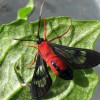Abstract
The scarlet-bodied wasp moth, Cosmosoma myrodora (Dyar), is a beautiful native insect. Because of its striking adult coloration, including a bright red thorax and abdomen, and transparent wings patterned with black, this moth immediately stands out in Florida landscapes. Larval feeding is restricted to two native plants in the genus Mikania, family Asteraceae. This 5-page fact sheet was written by Diego Moscoso, Rodrigo Diaz, and William A. Overholt, and published by the UF Department of Entomology and Nematology, May 2013.
References
Castillo JA. 2012. Desarrollo de Cosmosoma myrodora y Estigmene acrea (Lepidoptera: Arctiidae) en la maleza Mikania micrantha y las plantas nativas Mikania cordifolia y Mikania scandens (Asteraceae) en Florida. (Tesis de bachiller). Zamorano University. Zamorano, Honduras. 23p.
Conner W, Boada R, Schoroeder F, Gonzalez A, Meinwald J, Eisner T. 2000. Chemical defense: bestowal of a nuptial alkaloidal garment by a male moth on its mate. Proceedings of the National Academy of Sciences USA 97: 14406-14411. https://doi.org/10.1073/pnas.260503797
Torres JA. 1992. Lepidoptera outbreaks in response to successional changes after the passage of Hurricane Hugo in Puerto Rico. Journal of Tropical Ecology 8: 285-298. https://doi.org/10.1017/S0266467400006544
Unless otherwise specified, articles published in the EDIS journal after January 1, 2024 are licensed under a Creative Commons Attribution-NonCommercial-NoDerivs 4.0 International (CC BY-NC-ND 4.0) license.

